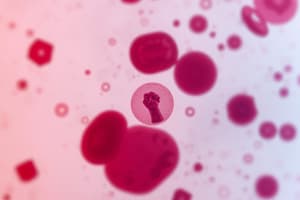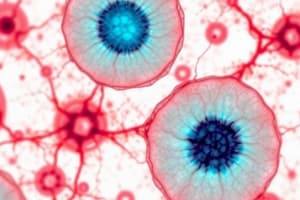Podcast
Questions and Answers
What is the approximate percentage of liquid in the blood?
What is the approximate percentage of liquid in the blood?
- 90%
- 20%
- 70% (correct)
- 40%
What happens when blood is mixed with anticoagulant?
What happens when blood is mixed with anticoagulant?
- The liquid part becomes thicker
- It solidifies immediately
- It forms a solid clot faster
- Clotting is prevented (correct)
Which component of the blood is nearly 90% water?
Which component of the blood is nearly 90% water?
- Leukocytes
- Erythrocytes
- Serum
- Plasma (correct)
What is the preferred anticoagulant mentioned in the text?
What is the preferred anticoagulant mentioned in the text?
Which component is present in plasma but not in serum?
Which component is present in plasma but not in serum?
How many populations are the cells of the blood divided into?
How many populations are the cells of the blood divided into?
What is the main function of leukocytes (white blood cells)?
What is the main function of leukocytes (white blood cells)?
What is the difference between granulocytes and agranulocytes?
What is the difference between granulocytes and agranulocytes?
What is the main function of neutrophils?
What is the main function of neutrophils?
What is the difference between segmented neutrophils and band neutrophils?
What is the difference between segmented neutrophils and band neutrophils?
What is the normal range for segmented neutrophils in adults?
What is the normal range for segmented neutrophils in adults?
What is the normal range for band neutrophils in adults?
What is the normal range for band neutrophils in adults?
What is the primary function of erythrocytes (red blood cells)?
What is the primary function of erythrocytes (red blood cells)?
Which of the following statements about erythrocytes is true?
Which of the following statements about erythrocytes is true?
What is the normal range for the mean corpuscular volume (MCV) of erythrocytes?
What is the normal range for the mean corpuscular volume (MCV) of erythrocytes?
What is the term used to describe young erythrocytes that contain ribonucleic acid (RNA)?
What is the term used to describe young erythrocytes that contain ribonucleic acid (RNA)?
What is the term used to describe erythrocytes that appear slightly more blue in color on a blood smear?
What is the term used to describe erythrocytes that appear slightly more blue in color on a blood smear?
What is the normal range for the erythrocyte (red blood cell) count in blood?
What is the normal range for the erythrocyte (red blood cell) count in blood?
What is the normal percentage range of eosinophils in the total white blood cell count?
What is the normal percentage range of eosinophils in the total white blood cell count?
Which of the following is NOT a function of eosinophils?
Which of the following is NOT a function of eosinophils?
Which molecule represents 50% of the content in the major granules of eosinophils?
Which molecule represents 50% of the content in the major granules of eosinophils?
Which of the following granule contents in eosinophils has a toxic effect by catalyzing the production of reactive oxygen species (ROS)?
Which of the following granule contents in eosinophils has a toxic effect by catalyzing the production of reactive oxygen species (ROS)?
What is the primary function of the Charcot-Leyden protein found in the primary granules of eosinophils?
What is the primary function of the Charcot-Leyden protein found in the primary granules of eosinophils?
Which of the following conditions is associated with an increase in eosinophil count?
Which of the following conditions is associated with an increase in eosinophil count?
Why does the number of bands increase with acute stress or infection?
Why does the number of bands increase with acute stress or infection?
Why can't neutrophils return to the blood once they have entered the tissues?
Why can't neutrophils return to the blood once they have entered the tissues?
What is the primary function of neutrophils in the tissues?
What is the primary function of neutrophils in the tissues?
What percentage of the vascular pool of neutrophils is in the marginating pool?
What percentage of the vascular pool of neutrophils is in the marginating pool?
What is the significance of the marginating pool of neutrophils?
What is the significance of the marginating pool of neutrophils?
Flashcards are hidden until you start studying




